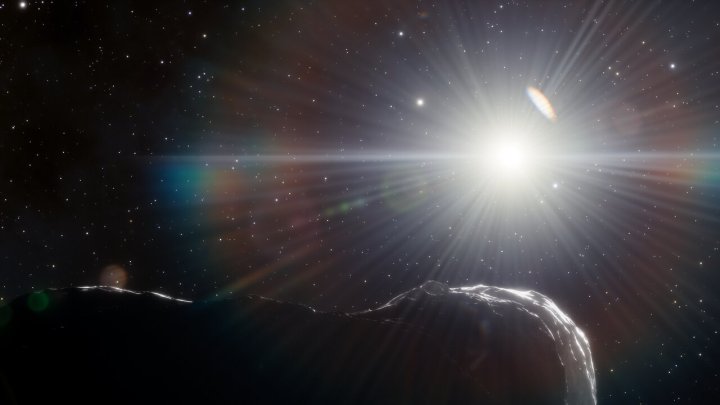Huge planet killer asteroid spotted between Earth and Venus
In sinister news for a spooky day, astronomers announced that they have spotted a huge asteroid nearly a mile wide thst could one day intersect with Earth’s path. The asteroid, along with two others, had been hiding in the glare from the sun, but was spotted using an Earth-based instrument called the Dark Energy Camera (DECam).
The three asteroids orbit between the orbits of Earth and Venus, but only the largest has an orbit that comes close to Earth’s orbit. This one, named 2022 AP7, is the largest potentially hazardous asteroid discovered in eight years.
The astronomers were able to spot these asteroids by looking during twilight hours, when there is a short period in which they can observe with less glare from the sun. The observations were taken as part of a survey looking for asteroids in the inner solar system, which are difficult to view because of the sun’s brightness.
“Our twilight survey is scouring the area within the orbits of Earth and Venus for asteroids,” lead researcher Scott S. Sheppard of the Carnegie Institution for Science explained in a statement. “So far, we have found two large near-Earth asteroids that are about 1 kilometer across, a size that we call planet killers.”
As alarming as the term “potentially hazardous asteroid” sounds, you don’t need to start panicking yet. An asteroid given this classification is one that comes close to Earth — in this case 0.05 times the distance between the Earth and the sun. But based on current observations, the asteroid won’t make any close approaches to Earth any time soon.
Observations of asteroids that come close to Earth are getting more common as we develop better tools for detecting them, but there likely aren’t many very large asteroids left to find because these are relatively easy to spot.
“There are likely only a few NEAs with similar sizes left to find, and these large undiscovered asteroids likely have orbits that keep them interior to the orbits of Earth and Venus most of the time,” said Sheppard. “Only about 25 asteroids with orbits completely within Earth’s orbit have been discovered to date because of the difficulty of observing near the glare of the sun.”
The research is published in The Astronomical Journal.
Editors’ Recommendations
In sinister news for a spooky day, astronomers announced that they have spotted a huge asteroid nearly a mile wide thst could one day intersect with Earth’s path. The asteroid, along with two others, had been hiding in the glare from the sun, but was spotted using an Earth-based instrument called the Dark Energy Camera (DECam).
The three asteroids orbit between the orbits of Earth and Venus, but only the largest has an orbit that comes close to Earth’s orbit. This one, named 2022 AP7, is the largest potentially hazardous asteroid discovered in eight years.

The astronomers were able to spot these asteroids by looking during twilight hours, when there is a short period in which they can observe with less glare from the sun. The observations were taken as part of a survey looking for asteroids in the inner solar system, which are difficult to view because of the sun’s brightness.
“Our twilight survey is scouring the area within the orbits of Earth and Venus for asteroids,” lead researcher Scott S. Sheppard of the Carnegie Institution for Science explained in a statement. “So far, we have found two large near-Earth asteroids that are about 1 kilometer across, a size that we call planet killers.”
As alarming as the term “potentially hazardous asteroid” sounds, you don’t need to start panicking yet. An asteroid given this classification is one that comes close to Earth — in this case 0.05 times the distance between the Earth and the sun. But based on current observations, the asteroid won’t make any close approaches to Earth any time soon.
Observations of asteroids that come close to Earth are getting more common as we develop better tools for detecting them, but there likely aren’t many very large asteroids left to find because these are relatively easy to spot.
“There are likely only a few NEAs with similar sizes left to find, and these large undiscovered asteroids likely have orbits that keep them interior to the orbits of Earth and Venus most of the time,” said Sheppard. “Only about 25 asteroids with orbits completely within Earth’s orbit have been discovered to date because of the difficulty of observing near the glare of the sun.”
The research is published in The Astronomical Journal.
Editors’ Recommendations
